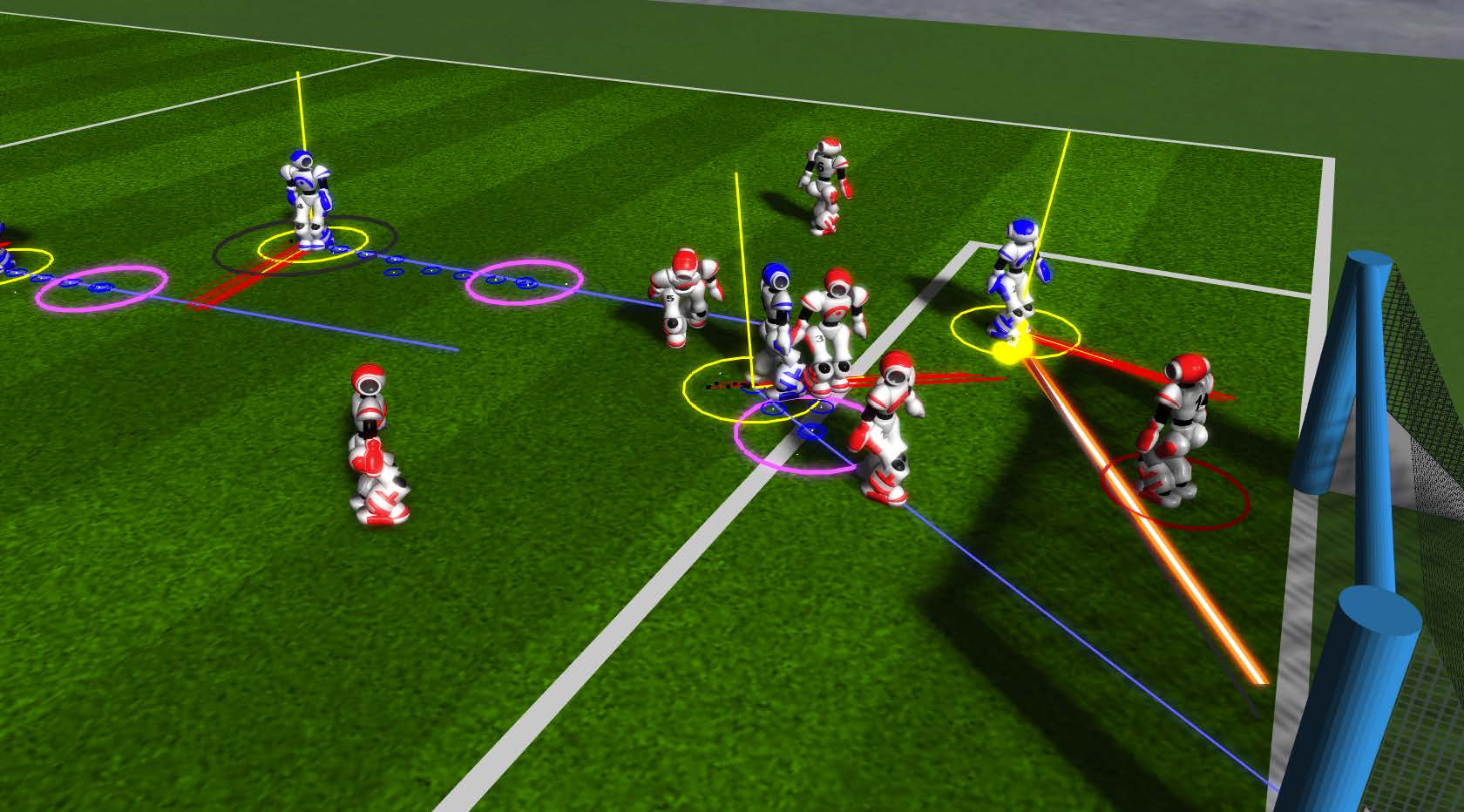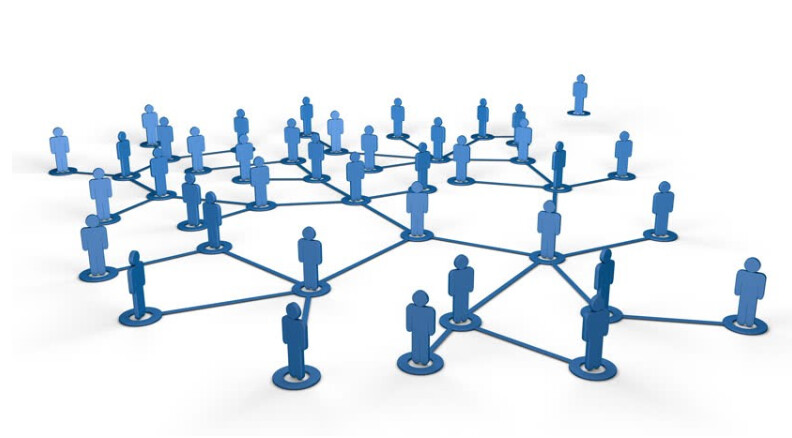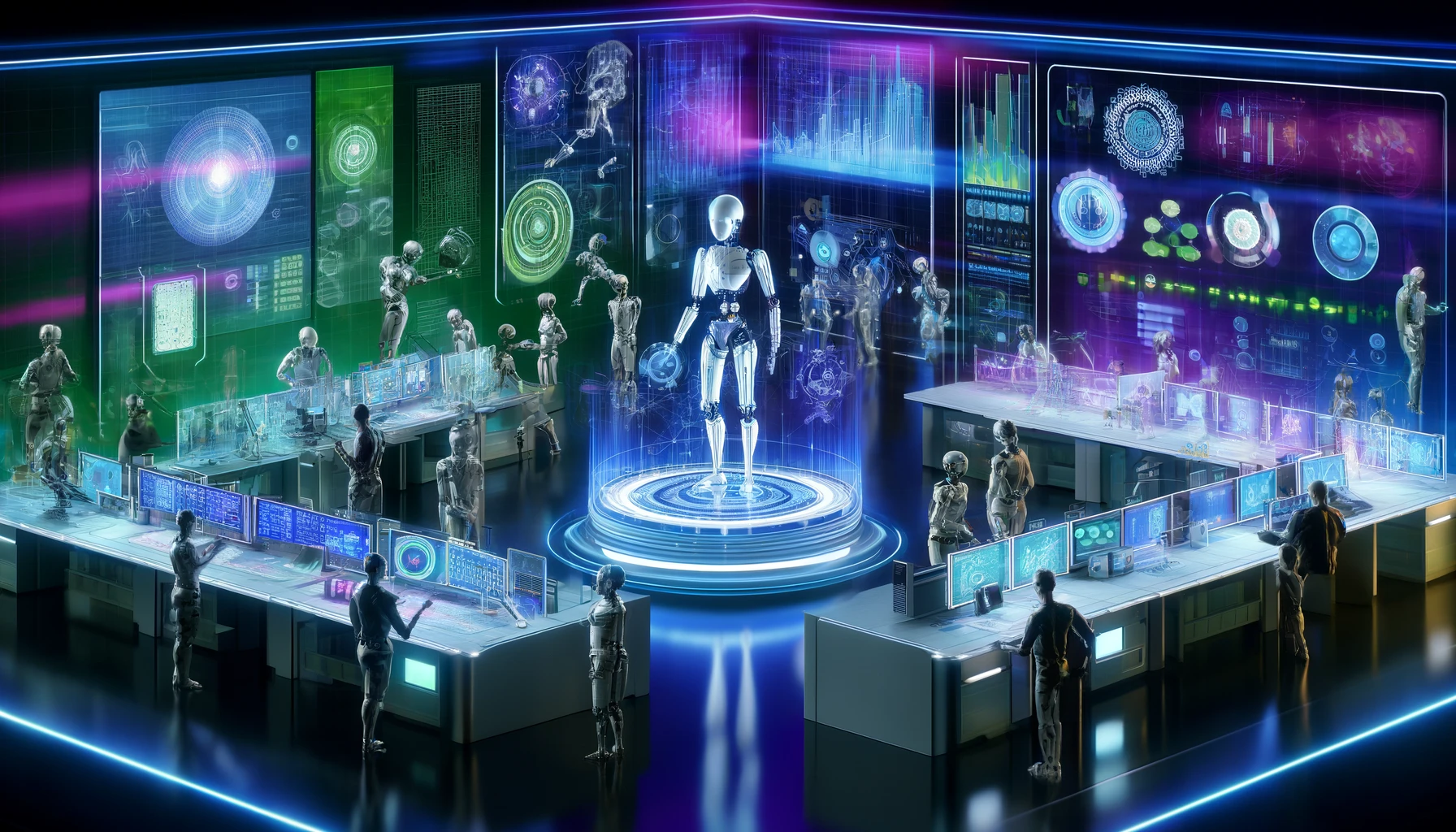Imagine a world where video game characters think for themselves, collaborate, and adapt to your every move. That’s the power of multi-agent systems in gaming. These intelligent systems are transforming how games are made and played, making them more exciting and lifelike.
Multi-agent systems consist of AI-powered agents that interact with each other and their environment. In games, these agents can be characters, objects, or even invisible helpers that make the game world feel alive. They function like a team of mini-brains working together to create amazing experiences for players.
What can these systems do? They excel at creating dynamic game worlds that evolve independently. Imagine exploring a forest where trees and animals appear naturally without game designers placing each one by hand. This is called procedural content generation, one of the many capabilities of multi-agent systems.
These systems also enhance gameplay by creating intelligent opponents. In strategy games, for instance, enemy units can collaborate and devise clever plans to defeat you. It’s like playing against a team of mini-geniuses!
However, developing these systems can be challenging. Game makers must ensure that the agents work well together and do not cause issues. It’s like being a referee for a bunch of robot players – you need to keep everyone in line!
This article explores how multi-agent systems are used in games, their benefits, and the challenges they present. Whether you’re a game developer or just someone who loves to play, you’ll learn how these smart systems are shaping the future of gaming. Get ready to see games in a whole new way!
Procedural Content Generation with Multi-agent Systems
Imagine booting up your favorite game for the hundredth time, only to find yourself exploring an entirely new world filled with landscapes and challenges you’ve never encountered before. This isn’t a fever dream or a glitch in the matrix; it’s the magic of procedural content generation (PCG) at work.
PCG functions like a tireless digital artist, constantly crafting new game elements behind the scenes. Instead of painstakingly handcrafting every tree, building, or quest, developers can set up algorithms to generate content dynamically. It’s the difference between painting individual pictures and inventing a machine that can create endless unique artworks.
This is where multi-agent systems come into play. These systems resemble collaborative teams of specialized AI artists, with each agent contributing its own expertise to the content creation process. For example, one agent might focus on terrain generation, another on object placement, and a third on ensuring everything conforms to the game’s rules and balance.
The Power of Collaboration
Multi-agent systems take PCG to new heights by introducing a level of complexity and coordination that single algorithms struggle to achieve. Imagine a city-building game where one agent designs the layout of the streets, another places the buildings, and a third populates those buildings with NPCs—all working in harmony to create a living, breathing urban environment.
This collaborative approach allows for the creation of game maps that are not only vast but also intricate and logically consistent. Gone are the days of repetitive patterns or nonsensical layouts that disrupt immersion. Multi-agent PCG can create worlds that feel organic and alive.
Enhancing Player Experience
The benefits of this advanced PCG approach extend far beyond making developers’ lives easier. For players, it means:
- Increased Replayability: Every playthrough can offer a genuinely new experience.
- Deeper Immersion: Environments feel more natural and less “designed.”
- Emergent Gameplay: The complex interactions between generated elements can lead to unexpected and exciting scenarios.
Take a game like Minecraft as an example. While it doesn’t specifically use multi-agent systems, its procedural world generation gives players a sense of true exploration. Now, imagine that level of discovery applied to more narrative-driven games, where the landscapes, quests, and characters you encounter are dynamically generated by a team of specialized AI agents.
Challenges and Future Potential
Of course, implementing effective multi-agent PCG systems isn’t without its challenges. Ensuring that the various agents work together seamlessly, maintaining game balance, and avoiding the generation of nonsensical or game-breaking content are all ongoing areas of research and development. Despite these hurdles, the potential is enormous. As these systems become more sophisticated, we could see games that essentially write themselves, creating endless, unique content tailored to individual player preferences and play styles.
The future of gaming isn’t solely about better graphics or faster processors; it’s about creating living, breathing worlds that surprise and delight us with every play. As multi-agent PCG systems continue to evolve, they promise to revolutionize not just how games are made but how we experience them. The line between game designer and player may blur as we become co-creators in ever-expanding digital universes.
The next time you embark on a gaming adventure, remember—you might be stepping into a world that didn’t exist until the moment you pressed ‘Start’.
Strategic Interactions in Competitive Gaming

Multi-agent systems have transformed competitive gaming, introducing complex strategic interactions. These systems enable game developers to create opponents that compete, cooperate, and adapt, mirroring human gameplay intricacies. The result is a more immersive and challenging experience for players.
At its core, a multi-agent system in gaming consists of multiple AI entities, each with its own goals, knowledge, and capabilities. These agents interact within the game environment, making decisions based on their programming and the actions of other agents. This dynamic interplay creates a rich tapestry of strategic possibilities, far beyond what traditional AI opponents can offer.
Simulating Realistic Opponents
One of the primary advantages of multi-agent systems in competitive gaming is their ability to simulate more realistic opponents. Unlike scripted AI that follows predetermined patterns, agents in these systems can:
- Adapt their strategies based on the player’s actions
- Learn from past encounters to improve performance
- Collaborate with other AI agents to form complex tactics
- Exhibit unpredictable behavior, keeping players on their toes
| Aspect | Traditional AI | Multi-Agent Systems |
|---|---|---|
| System Design | Predefined, rule-based systems | Multiple AI agents working together |
| Adaptability | Limited adaptability, struggles with unanticipated actions | Highly adaptable, can respond dynamically in real-time |
| Creativity | Constrained by predefined rules | Generates novel content and behaviors |
| Development Complexity | Lower complexity, stable and predictable | Higher complexity, requires coordination between agents |
| Computational Resources | Lower computational demands | Higher computational demands |
| Player Experience | Predictable and controlled | More immersive and personalized |
| Example Usage | Classic platformers, strategy games | Modern RPGs, open-world games |
Consider the popular strategy game StarCraft II. Here, multi-agent systems have been used to create AI opponents that can formulate intricate battle plans, manage resources efficiently, and even employ deceptive tactics – all hallmarks of high-level human play.
Enhancing Player Experience
The implementation of multi-agent systems in competitive gaming significantly enhances the player experience in several ways:
Increased Challenge: As agents become more sophisticated, they provide a consistently challenging experience for players of all skill levels. This scalable difficulty keeps the game engaging over time.
Dynamic Gameplay: The adaptive nature of multi-agent systems ensures that no two gaming sessions are exactly alike. This variability keeps the gameplay fresh and exciting.
Skill Development: By facing intelligent and adaptable opponents, players are encouraged to refine their own strategies and improve their skills continuously.
Real-World Applications
The strategic interactions facilitated by multi-agent systems in gaming have applications beyond entertainment. For instance:
Military Simulations: Multi-agent systems are used to create realistic war game scenarios, helping strategists plan and prepare for various contingencies.
Economic Modeling: In games that simulate market economies, multi-agent systems can model complex economic interactions, providing insights into real-world financial systems.
Urban Planning: City-building games employing multi-agent systems can simulate the intricate interactions of urban development, offering valuable lessons for actual urban planners.
The Future of Multi-Agent Systems in Gaming
As artificial intelligence continues to advance, we can expect multi-agent systems in competitive gaming to become even more sophisticated. Future developments may include:
- Agents with more advanced learning capabilities, potentially using deep reinforcement learning
- Improved natural language processing, allowing for more realistic communication between AI agents and human players
- Integration with virtual and augmented reality to create even more immersive gaming experiences
The evolution of multi-agent systems in competitive gaming is not just enhancing player experiences – it’s reshaping the very nature of strategic interactions in virtual environments. As these systems continue to develop, they promise to push the boundaries of what’s possible in competitive gaming, offering players increasingly realistic, challenging, and engaging experiences.
Real-World Applications of Multi-agent Systems
Multi-agent systems (MAS) have made significant contributions beyond gaming AI, addressing complex challenges in society such as optimizing traffic flow and simulating economic markets. Let’s explore how MAS applications in various industries are solving critical problems and enhancing gaming technologies through a fascinating cross-pollination of innovation.
Taming Urban Congestion with AI Teamwork
Imagine cruising down a busy city street, with every traffic light turning green as you approach. This is the work of a sophisticated multi-agent system orchestrating urban traffic flow. In cities like Boston and Birmingham, MAS are revolutionizing traffic management by treating each intersection as an autonomous agent capable of communicating with its neighbors.
These AI-powered traffic systems analyze real-time data from sensors and cameras, adjusting signal timings to reduce congestion and prioritize emergency vehicles. Some cities report up to a 25% reduction in travel times and a significant decrease in emissions. Game developers are using similar principles to create more realistic and dynamic traffic simulations in open-world games.
Economic Crystal Balls: Multi-agent Market Simulations
In finance, predicting market behavior is challenging. Multi-agent economic simulations, where thousands of AI agents mimic the behaviors of investors, companies, and regulators, serve as powerful tools for policymakers and researchers. They allow testing the potential impacts of new regulations or economic shocks in a risk-free environment.
The European Central Bank, for example, uses MAS to simulate scenarios such as stock market crashes and the introduction of new cryptocurrencies. These simulations provide invaluable insights that help shape real-world economic policies. Game developers are leveraging similar techniques to create more nuanced and realistic in-game economies.
Healthcare Heroes: Coordinating Care with AI
In healthcare, multi-agent systems are emerging as unsung heroes. Imagine a hospital where AI agents representing different departments work in harmony to optimize patient care. These systems can coordinate resources, prioritize cases, and predict potential complications before they arise.
A Boston hospital uses a MAS to coordinate organ transplant logistics, matching donors with recipients, planning transportation, and predicting potential issues. This system has increased successful transplants by 15% and reduced wait times by nearly a month. Game developers are inspired to create more sophisticated AI teammates in multiplayer games, capable of adapting to player behavior and making split-second decisions.
Cross-Pollination: From Reality to Virtual Worlds and Back
The versatility of multi-agent systems lies in their cross-industry benefits. Techniques developed for traffic management are being used in real-time strategy games to create more challenging and adaptive enemy AI. Conversely, reinforcement learning algorithms from gaming environments are optimizing real-world supply chains and manufacturing processes.
Dr. Sarah Chen, a leading transplant surgeon, notes,
Challenges in the Development of Multi-agent Systems

Visualizing collaboration among agents in a network. – Via ac.be
Creating effective multi-agent systems (MAS) is no small feat. As these sophisticated AI networks grow more complex, developers face significant hurdles in bringing them to life. This section delves into two key challenges – integration issues and training data biases – while offering practical strategies to build more robust and capable multi-agent systems.
Integration Issues: Bringing Agents Together
One of the primary obstacles in MAS development is seamlessly integrating multiple autonomous agents. Each agent may have its own goals, decision-making processes, and communication protocols. Getting these diverse components to work in harmony can be incredibly tricky.
Compatibility problems often arise when agents built on different platforms or using varied programming languages need to interact. This can lead to communication breakdowns or conflicting behaviors that undermine the system’s overall effectiveness.
Additionally, as the number of agents in a system grows, so does the complexity of their interactions. This scalability challenge can quickly overwhelm developers and lead to performance bottlenecks.
| Compatibility Issue | Description |
|---|---|
| Communication Protocols | Different agents may use varied communication protocols, leading to integration problems. |
| Platform Diversity | Agents built on different platforms or programming languages may face compatibility issues. |
| Scalability | As the number of agents grows, managing interactions and performance becomes more complex. |
| Conflicting Goals | Agents with different objectives may cause conflicts, undermining system effectiveness. |
| Data Exchange | Inconsistent data formats can lead to communication breakdowns between agents. |
Strategies for Smoother Integration
To tackle these integration hurdles, consider the following approaches:
- Standardized Communication Protocols: Implement well-defined APIs and messaging formats to ensure all agents can effectively ‘speak’ to one another, regardless of their underlying architecture.
- Modular Design: Build agents as independent modules with clear interfaces. This makes it easier to add, remove, or update individual agents without disrupting the entire system.
- Centralized Coordination: Introduce a ‘manager’ agent or middleware layer to oversee communication and task allocation between agents, reducing direct dependencies.
- Extensive Testing: Develop comprehensive integration tests that simulate various agent interactions and system states to identify potential conflicts early.
Training Data Biases: The Hidden Threat
The performance of multi-agent systems heavily relies on the quality and diversity of their training data. Unfortunately, biases present in this data can lead to skewed decision-making and unfair outcomes.
These biases might stem from historical inequalities, underrepresentation of certain groups, or flawed data collection methods. When baked into MAS, they can perpetuate and even amplify existing societal biases, leading to discriminatory behavior in areas like hiring, lending, or law enforcement.
Combating Bias for Fairer Systems
Addressing training data biases requires a multi-faceted approach:
- Diverse Data Sources: Actively seek out training data from a wide range of sources to ensure representation across different demographics and perspectives.
- Bias Detection Tools: Utilize specialized software to analyze your training data and identify potential biases before they make their way into your agents.
- Regular Audits: Continuously monitor your MAS for biased outcomes, even after deployment. Be prepared to retrain or adjust agents if problematic patterns emerge.
- Ethical Guidelines: Develop clear ethical standards for your MAS and incorporate them into the training and decision-making processes of individual agents.
- Transparency: Make your system’s decision-making process as transparent as possible, allowing for easier identification and correction of biases.
Building More Robust Multi-Agent Systems
By tackling integration challenges and data biases head-on, developers can create multi-agent systems that are not only more effective but also more equitable. This proactive approach leads to MAS that are:
- More adaptable to changing environments and requirements
- Better able to handle complex, real-world scenarios
- More trustworthy and ethically sound
- Capable of producing fairer outcomes across diverse user groups
As multi-agent systems continue to evolve and take on increasingly important roles in our society, addressing these fundamental challenges becomes crucial. By implementing the strategies outlined above, developers can create MAS that are not just powerful, but also responsible and truly beneficial to all.
The Role of SmythOS in Developing Multi-agent Systems

Humanoid robots collaborating in a futuristic office space. – Via smythos.com
SmythOS is transforming the development of multi-agent systems, offering a robust platform for creating, deploying, and managing complex AI networks. With powerful tools and features, SmythOS enables developers to build sophisticated and efficient multi-agent systems easily.
One standout feature of SmythOS is its built-in monitoring capabilities. This functionality allows developers to monitor the performance and interactions of individual agents within the system in real-time. This ensures potential issues are identified and addressed quickly, maintaining the overall health and efficiency of the multi-agent network.
Integration is another strength of SmythOS. The platform offers seamless compatibility with various existing tools and systems, allowing developers to incorporate multi-agent functionality into their current projects without major overhauls. This easy integration reduces development time and resources, enabling faster deployment of AI solutions.
SmythOS also boasts automatic scaling capability. As the demands on a multi-agent system grow, SmythOS dynamically allocates resources and adjusts the system’s capacity to maintain optimal performance. This feature is especially valuable for businesses dealing with fluctuating workloads or rapidly expanding AI applications.
The practical applications of SmythOS in multi-agent systems development are vast. From enhancing customer service with intelligent chatbots to optimizing supply chain management through coordinated AI agents, the platform opens up new possibilities across various industries. For instance, a retail company could use SmythOS to develop a network of AI agents that manage inventory, predict demand, and coordinate with suppliers while seamlessly scaling to handle seasonal spikes in activity.
By streamlining the development process and providing robust tools for deployment and maintenance, SmythOS is expanding the horizons of AI. As businesses and organizations continue to recognize the potential of multi-agent systems, SmythOS stands poised to play a crucial role in shaping the future of AI development.
SmythOS is transforming multi-agent AI development with built-in monitoring, easy integration, and automatic scaling. It’s not just a platform; it’s the future of efficient, scalable AI solutions. #SmythOS #AIInnovation #MultiAgentSystems
Conclusion and Future Directions in Multi-agent Systems
Multi-agent systems are set to transform player experiences in gaming, unlocking new levels of interactivity and immersion. Developers are leveraging sophisticated AI to create virtual worlds filled with life and reactivity.
In the future, we can expect autonomous agents that learn and adapt to player behavior in real-time. Imagine NPCs with long-term memories that evolve relationships organically over a game’s course. Consider dynamic ecosystems where every entity, from the smallest creature to sweeping weather patterns, operates with unprecedented independence.
Challenges remain, such as scaling these systems to support massive, persistent worlds, which will require innovative solutions in distributed computing and network optimization. Balancing agent autonomy with narrative coherence is another hurdle – ensuring engaging storylines when characters can make unpredictable choices.
Despite these obstacles, passionate developers are pushing boundaries. Platforms like SmythOS are instrumental, offering powerful tools that democratize AI development. With visual workflow builders and robust debugging environments, even small studios can now create complex multi-agent systems that rival industry giants.
The games of tomorrow will be more than just entertainment. They will be living, breathing worlds that challenge our notions of interactive media. For players and developers alike, the future of multi-agent systems in gaming is not just bright – it’s exhilarating.
